In this post, you'll learn 22 scarlet macaw facts. They include appearance, habits, threats, and more. Plus lots of photos and videos.

Table of Contents
22 Facts about the Scarlet Macaw
Macaws are beautiful! These vibrantly colored birds are as intelligent as they are stunning. Which, of course, makes them an avian of interest.
What is it that draws us to these creatures? Where do they live? What kind of food do they enjoy? Those are a few of the questions we’re going to answer.
1. What does a scarlet macaw look like?
The name scarlet macaw seems pretty descriptive, but what does it actually look like? Well, according to the Rainforest Alliance, a scarlet macaw is fantastically brilliant!
A white, barely feathered area encircles bright eyes, leading into the ravishing red feathers covering most of this gorgeous bird’s body.
The wingtips and tail feathers are a deep blue and sunny yellow, giving this bird a reason to preen that has nothing to do with pea-cocking.
Click here to watch on Youtube
2. How big is a scarlet macaw?
Macaws are among the largest in the parrot grouping.

Scarlet macaws are one of the largest in length/height for its species. Measuring in at nearly 3 feet, 81 centimetres or 32 inches, almost half of that length is made up by the scarlet macaw’s tapered tail.
3. What is the scarlet macaw’s wingspan?
he Scarlet Macaw’s wingspan is right at about 1 meter or roughly 3 feet.

4. How much does a scarlet macaw weigh?
An average adult scarlet macaw will weigh up to about 1 kilogram, or 2.2 pounds.
5. Why is a scarlet macaw so colorful?
There’s no doubt that the scarlet macaw is colorful. While the scarlet macaw’s plumage might make it stand out in a Kansas field, in its home territory it blends perfectly in.

It is indigenous to the South American rainforest, with vivid flowers and brightly colored fruits and berries. The scarlet macaw, if left in their natural habitat, would be perfectly camouflaged against most predators.
6. Do scarlet macaws talk?
Like all macaws, the scarlet macaw will mimic human speech. They are highly social animals and can be taught words or phrases easily.
They mimic their environment and the humans they are closest to, and just like children, will “parrot” most phrases you wouldn’t necessarily want them to. So be careful what you say around your scarlet macaw, or your face could be just as red as their plumage.
7. Are scarlet macaws friendly? Or aggressive?
Scarlet macaws bred in captivity are quite affectionate. Hand-feeding helps to earn your macaw’s affection and trust, but keep in mind, these are loud, raucous, and social birds. They have the ability to become aggressive – especially if they aren’t given enough stimulus.
In the wild, scarlet macaws are neither friendly or aggressive but simply keep to themselves. You have little to fear from a scarlet macaw.
8. Do scarlet macaws make good pets?
They’re intelligent, but not made to be alone. If you have a job or responsibilities that keep you out of your home, your scarlet macaw will need a friend to keep it company.
If they become lonely, they’ll develop nervous habits like biting or tearing out their own feathers.
Because of their loud nature and large stature, they’re also not recommended for apartment living. These birds need room and lots of it! To be a good macaw pet parent, it’s essential to research the bird before deciding to adopt one.
It is also important to note that captive-bred macaws are typically hybrids.
Deforestation is eating into the scarlet macaw bird population, and like many macaws, they’re close to being on the endangered species list.
Because all macaws can interbreed, it is highly suggested to bird-breeders to mix their macaws so that they aren’t liable for trading in exotic but endangered birds.
9. How long do scarlet macaws live?
If you’re considering becoming a pet parent to a scarlet macaw, keep in mind that these gorgeous creatures can live up to 75 years
Their average life-span is closer to 50-60 years. These are lifelong companions, and barring any sudden illnesses or injury, will likely live just as long as you do. If not longer. It’s important that these birds are well-taken care of, so if you are planning to add them to your family, you will need to make provisions for them.
10. What eats a scarlet macaw? Predators and threats
According to animaldiversity.org scarlet macaws, by sheer size, thwart most predators. They are at their most vulnerable in the nest.
Hatchlings can be hunted by snakes, monkeys, and a few other small predators. Adult or fledgling scarlet macaws are hunted by larger jungle cats or larger birds like the eagle.
The main predator of a scarlet macaw is actually humans. The rise of deforestationhas seen a devastating decline in macaw numbers.
Likewise, because these birds are so beautiful, they’re in ***danger of poaching and smuggling. *** Poachers will kill the adult parents for their gorgeous plumage and then smuggle the chicks into a legitimized market for these lovely animals.
11. How does the scarlet macaw protect itself?
They have wings and they know how to use them! The scarlet macaw’s first line of defense is to simply fly away.
If for some reason that isn’t an option, the macaw is equipped with a curved beak and wicked talons. The bird will bite or scratch the predator, and use those enormous wings to bat the offender into submission.

Another way the macaw might protect itself is turning tail. With its tail feathers making up half its body length, a predator would only get a mouthful of feathers on the first bite, letting the macaw get away relatively safely and mostly unharmed.
12. What do scarlet macaws typically eat?
Thanks to their strong, curved beaks, scarlet macaws are quite happy munching on nuts as well as the prevalent fruits and berries that grow in their natural habitat.
Because they are avid fruit-eaters, they are also considered ‘seed bearers’ as a species. They can be a highly effective tool for reseeding deforested areas with the local fruit trees, as their droppings will contain seeds from the fruit they consume.
Colorful and Funny
Have a question about scarlet macaws? Or maybe a fact to share? Join us in the comments!